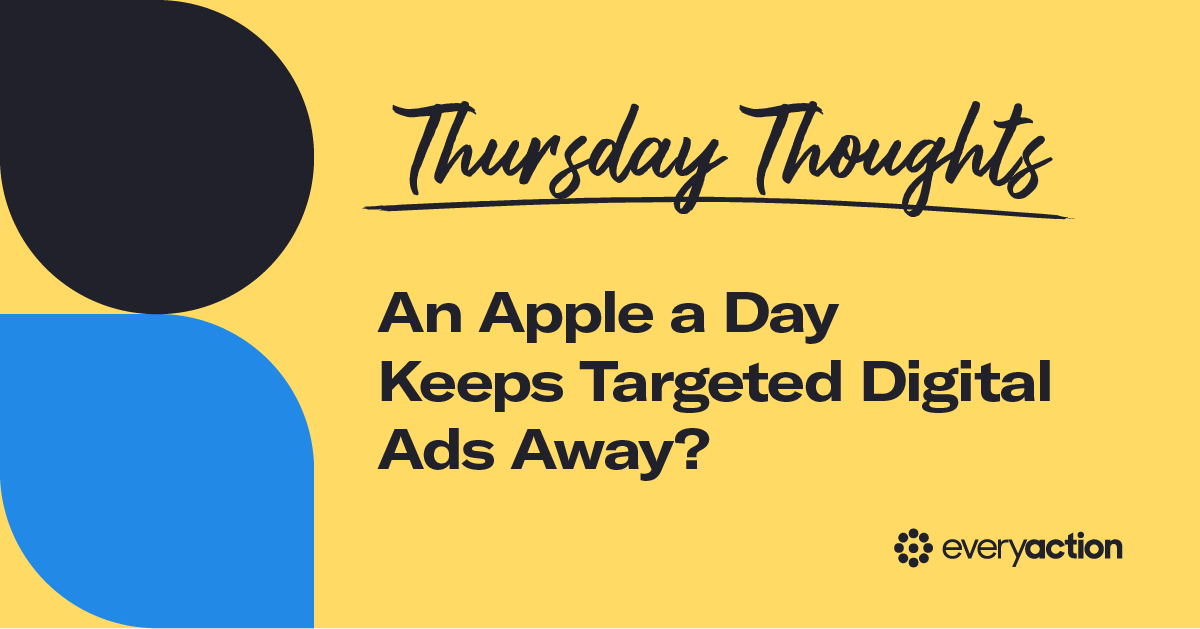Thursday Thoughts: An Apple a Day Keeps Targeted Digital Ads Away?

Welcome to another installment of Thursday Thoughts, a dedicated space for our friends in nonprofit sector leadership to reflect on reports, statistics, and other trends—because when our community shares knowledge, we can all do more good. Check out last month’s post here.
Nonprofit sector leaders know how important it is to pay close attention to reports, statistics, and other trends in our community, because they know that knowledge can help them do more good. We asked our friend Eric Linssen at Community Boost, a digital marketing agency that works with nonprofits of all sizes and sectors, for his thoughts on one upcoming challenge that nonprofits have to prepare for by taking action now — here’s what he said.
In our world, managing digital ads for hundreds of nonprofits, Apple’s iOS 14 and 14.5 updates had a measurable impact on some of our clients’ ad campaigns.
For those who aren’t aware, with their iOS 14.5 updates, Apple has raised privacy standards for their users. Specifically, they are now requiring users’ explicit opt-in to use the IDFA, or Identifier for Advertisers, as they interact with apps—including in browsers like Google Chrome! Millions of people use Apple devices, and because not all users will explicitly opt-in to use the IDFA on their devices, this change means anyone running digital ads — including nonprofits who want to drive more traffic to their sites — will get less granular visibility into key actions prospective donors are taking after interacting with those ads.
Regardless of the details, this, along with recent legislation like GDPR and CCPA, are indicative of a larger trend: people care more about privacy now than they did in the past. The ‘golden age’ of hyper-targeted digital ads is over.
Here are 6 things that we as members of the forward-thinking nonprofit community can do to prepare our digital ads practices for this changing privacy environment:
- First, make sure your digital ad account is set up for success by setting up domain verification and limiting your number of events.
- Collect more first party data, more often — this simply means collecting more information directly from your audiences rather than third-party sources. (Want to learn more about how to optimize your forms for higher conversion rates, so you can successfully collect more first party data? Start here.)
- Keep engagement that you plan to retarget on platform — we can track almost everything a user does on a platform, including video views, post likes, and call-to-action clicks. This allows us to create cleaner audiences and allocate ad spend more effectively to the right people, at the right times.
- Set up the Conversions API for Facebook ads — this will work with the Facebook pixel to help improve the performance and measurement of Facebook ad campaigns.
- Invest in better, more engaging creative — as these privacy updates affect digital ads by forcing our targeting options to become less granular and specific, scroll-stopping creative becomes even more important to capture valuable donor attention and really move the fundraising needle. If you’re wondering what that might look like, here’s a place to start.
- Double-check all of your ads manager metrics with Google Analytics to make sure you’re not cutting spend on winning campaigns.
There’s a lot to consider with changes like these. Community Boost also recorded an hour-long webinar on these changes to digital ads — if you’re looking to go into meticulous detail on how you can prepare for this, view it on-demand.


